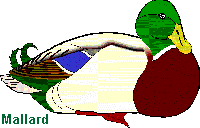
Pintail Lake
|
|
||
Welcome to Pintail Lake, a waterfowl marsh habitat project borne of the spirit of cooperation. 
In 1976, the Apache-Sitgreaves National Forest initiated its wetland management program with the objective of improving and increasing waterfowl habitat. One year later, the Forest entered into a cooperative agreement with the Arizona Game and Fish Department, Show Low Sanitary District, and the City of Show Low, Arizona. This cooperative venture between three levels of government outlined a plan to create man-made marsh ecosystems using treated wastewater. The Pintail Lake project was to become the first of its kind in the Southwestern Region of the USDA Forest Service. The objectives were two-fold: first to increase waterfowl production by creating lakes with nesting islands protected from livestock grazing, and; second to provide wastewater disposal for the City of Show Low. Marsh ecosystems have the ability to further treat wastewater by removing large quantities of organic nutrients. This process results in the lush growth of vegetation in the marsh system. Construction of Pintail Lake began in 1977. Within an existing natural depression, water control structures, two dikes, and fourteen nesting islands were built. The islands were seeded with several plant species and then covered with straw to retain moisture and protect the islands from erosion. In 1979, the 47-acre lake began receiving treated wastewater. Quantities increased from 200,000 gallons per day at the start to 500,000 gallons at present. A similar project in cooperation with the City of Pinetop-Lakeside, Arizona was planned at the same time and completed in 1984. This marsh ecosystem, known as Jacques Marsh is located just north of Lakeside. The project covers 97 acres and contains 18 nesting islands. Jacques Marsh is also on National Forest System lands. Current population projections for Show Low and Pinetop-Lakeside indicate both communities will rapidly expand. Other marshland ecosystems are planned or are under construction to use the additional treated effluent to enhance wildlife habitat. Doubts were expressed at the beginning of this project by some waterfowl experts in Arizona. The biggest question was, would the man-made islands you see here at Pintail be used by our so called "desert duck" and if so would waterfowl numbers actually increase? This has been answered and the result has been dramatic. According to Linden Piest, Research Assistant with the Arizona Cooperative Wildlife Research Unit, University of Arizona, the number of ducklings hatched at Pintail increased from 9 in 1979 to 2,819 by 1982. The increases were dramatic in each of the four years of Piest's study. The islands contained nearly 90% of the area's nests and increases in densities occurred during each of the first four years. Ducks nesting on islands enjoy improved nesting success because of reduced predation from mammals like coyotes or skunks. Production in recent years has declined because of lower quality wastewater entering the lake. Water quality is expected to improve with the new City of Show Low wastewater treatment facility. Waterfowl production at Pintail is expected to return to previous highs. Some waterfowl species you may see today are: Mallard, Northern
Pintail, Cinnamon and Green-Winged teal, Northern Shoveler, and Gadwall. An observation platform at the end of the entry trail provides excellent opportunity to view and photograph wildlife in the area. To further enhance wildlife viewing, an observation blind is planned on the edge of the middle marsh across from a nesting island. This will provide a rare educational opportunity to view and photograph a unique marshland ecosystem in the arid high country of Arizona. Please remember, we ask that you stay on the designated trails or in the observation area so nesting waterfowl will not be disturbed. Waterfowl habitat in North America is decreasing at the alarming rate of 2,000 acres per day, every day of the year. This loss further underlines the importance of projects like Pintail lake. Although the acreage here is small, it is none-the-less an important waterfowl habitat project because of the scarcity of marshland ecosystems in the arid Southwest and its high productivity. Other marshland projects on the Apache-Sitgreaves National Forest you may with to visit are: Redhead Lake, located one mile west of Pintail Lake, and Jacques Marsh located north of Lakeside Arizona. If you would like to know more about Pintail Lake and how it was formed and is operated, click here! Information courtesy: United States Department of Agriculture, Forest Service, and Apache-Sitgreaves National Forest. |
||
 Some
scientists feel that Pintail Lake has the highest nesting density of any marsh
island ecosystem. In addition to waterfowl, the marsh area attracts a variety
of other wildlife including deer, elk, antelope, Bald Eagles, songbirds and
numerous shorebirds and wading birds.
Some
scientists feel that Pintail Lake has the highest nesting density of any marsh
island ecosystem. In addition to waterfowl, the marsh area attracts a variety
of other wildlife including deer, elk, antelope, Bald Eagles, songbirds and
numerous shorebirds and wading birds.